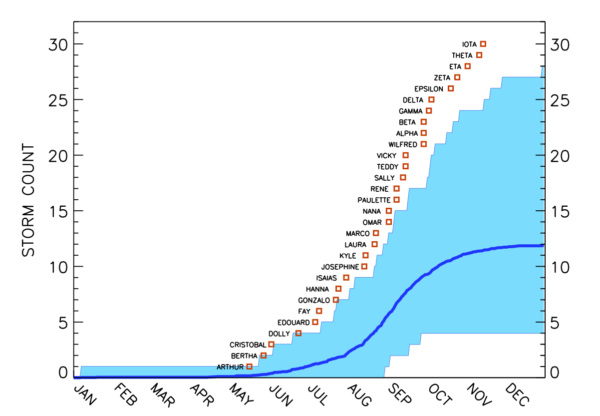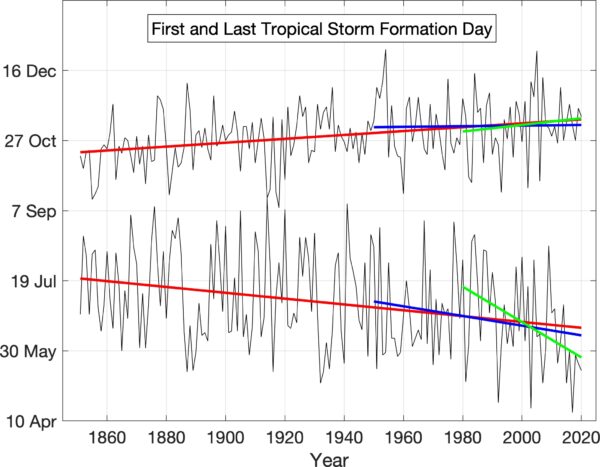Should the official Atlantic hurricane season be lengthened?
By Jim Kossin, Tim Hall, Mike Mann, and Stefan Rahmstorf
The 2020 Atlantic hurricane season broke a number of records, with the formation of an unprecedented 30 “named storms” (storms that reach wind-speed intensity of at least 18 m/s and are then given an official name). The season also started earlier than normal. In fact, when ranked by their order in the season, the date of formation of every named storm, from Tropical Storm Arthur to Hurricane Iota was substantially earlier than normal (Fig. 1).

In 2008, after a series of Atlantic hurricane seasons that began earlier than normal, a study was published that explored whether the anomalously early starts may be part of a larger trend (Kossin 2008). The results of that study identified increasing trends in the length of the active hurricane season, with storms forming earlier and later in the season than normal (Fig. 2), but there was quite a bit of uncertainty in the statistical significance of the trends, and additional uncertainty in the century-scale trends (red lines in Fig. 2) due to missing or uncertain data in the earlier part of the record. Still, regardless of statistical significance, there is clearly a very steep trend towards earlier storms in the past four decades (lower green line in Fig. 2), which represent a period of reliable data.

The official start to the Atlantic hurricane season has been set at June 1st since the 1960s, but this steep trend toward earlier storm formation over the past four decades has spurred many discussions about modifying this date, and the World Meteorological Organization has recently proposed that the National Hurricane Center extend the official start of the hurricane season backwards by two weeks to May 15th. If this pronounced tendency toward earlier storms over the past four decades is defining a “new normal”, then extending the season backwards by two weeks seems entirely supportable. Furthermore, there’s no question that the season length is linked to Atlantic sea-surface temperature (SST), with the season starting about 15–20 days earlier and about 15–20 days later per °C of anomalous Atlantic warming (Kossin 2008).
But this also raises other questions: 1) Can we expect the season to continue to lengthen as global warming from increasing concentration of globally well mixed greenhouse gas (GWM-GHG) continues to warm the Atlantic SSTs? and 2) Is there any process that might drive the new normal back to the old normal, thereby reducing the season length? Answering these two questions is the goal of this article.
While season length is clearly linked to Atlantic SST, it’s not so clear that this is part of a longer-term trend linked to global warming. In fact, there is quite a bit of uncertainty regarding the effect of GWM-GHG warming on tropical storm formation. Although some modeling studies find an increase in storm frequency related to GWM-GHG warming (e.g., Emanuel 2021; Hall et al. 2021; Knutson et al. 2020), many others do not. And some studies actually predict a decrease in frequency of tropical storm formation, both globally and in the North Atlantic (all while allowing those storms that do form to become more intense and produce more rain) (Knutson et al. 2019). If SST warming due to GWM-GHG does reduce Atlantic formation rates, or does not increase them substantially, then there is no clear and obvious expectation that this warming should cause further lengthening of the season.
This answers our first question, at least as far as we can, given the uncertainty in what we know about how formation rates respond to global warming. The answer is no. This doesn’t mean that it won’t happen; only that we don’t understand the physical relationships well enough and we don’t have the consistent numerical modeling results to form a clear expectation.
The statement that GWM-GHG SST warming may not increase storm formation rates might appear incongruent with the earlier statement that the season is about 30–40 days longer on average per °C of anomalous SST warming. But it emphasizes an important point about the relationship between SST and hurricane behavior in general: The hurricane response to SST changes depends on what caused the SST changes (Emanuel and Sobel 2013). In particular, Atlantic SST warming caused by local forcing does increase Atlantic tropical storm formation rates, while Atlantic SST warming caused by increased GWM-GHG concentration may not. The difference is due largely to the differences in the regional atmospheric response that occurs in concert with the SST warming.
The key to understanding this lies in understanding what tropical storms respond to. In particular, they don’t just respond to SST changes, but also how the atmosphere changes as the SSTs change. For example, warming caused by GWM-GHG can cause the atmosphere in some regions to become more stable and drier in the mid-levels (Knutson et al. 2020), and can cause an increase in vertical wind shear over the Atlantic (Kossin 2017; Ting et al. 2019). All three of these factors have a powerful quelling effect on tropical storm formation. So it’s okay to say that SST warming will increase storm formation rates, all other things equal, but all other things are not equal. It depends on what’s driving the warming because the atmosphere will respond differently depending on the driver. The local atmospheric response to warming can be strong enough to actually reduce formation rates in some regions even while that same warming is increasing the local SST.
In the North Atlantic, examples of local SST warming mechanisms that can increase Atlantic storm formation rates are:
- the reduction of sulfate pollution aerosols since the U.S. and European Clean Air Acts and Amendments of the 1970s (Mann and Emanuel 2006; Dunstone et al. 2013; Sobel et al. 2016),
- a reduction of Saharan dust concentration since the 1970s (Evan et al. 2009),
- a quiescent period of volcanic eruptions (Mann et al. 2021), and
- changes in the Atlantic Meridional Overturning Circulation (AMOC).
This brings us back to our second question: Is there any process that might drive the new normal back to the old normal, thereby reducing the season length? The external local forcing of Atlantic SST caused by decreasing sulfate and dust aerosols is bounded (concentration cannot become less than zero), so the resulting warming cannot be easily projected into the long term. It’s also (hopefully) unlikely that we would revert back to increasing sulfate pollution, so this doesn’t seem a likely candidate for a reversal of the warming trend. However, it is certainly possible that Saharan dust, which is carried over the Atlantic in the trade winds and exhibits variability on decadal to multidecadal timescales (Evan et al. 2016), could increase again in concentration. This would have a cooling effect on Atlantic SST, as well as a stabilizing effect on the regional atmosphere (Dunion and Velden 2004), and would be expected to reduce tropical storm formation frequency for some (possibly prolonged) period.
Internal AMOC variability has been argued to exhibit some decadal to multidecadal behavior (e.g., Zhang et al. 2016), in addition to a long-term decline (Caesar et al. 2021). But evidence for oscillatory internally-driven North Atlantic SST variability, sometimes referred to as an Atlantic Multidecadal Oscillation (AMO), is becoming increasingly challenged and disputed (e.g., Mann et al. 2020). If this variability is not oscillatory, then it is not predictable, and expectations that the “AMO should transition back to a cool phase soon” (e.g., Klotzbach et al. 2015) are not clearly supported. In fact, there is evidence that past observed decadal-to-multidecadal Atlantic SST variability, which is often considered to be the fingerprint of an internal AMOC oscillation (i.e., the AMO), may be entirely externally driven by volcanic eruptions (Mann et al. 2021). In this case, there is no reason to expect a transition to a period of cooler SST anytime soon, since there is no predictability in how volcanic eruptions will occur over these timescales. That being said, it is possible that the past cooling periods due to volcanic eruptions could occur again, just as it’s possible for Saharan dust concentrations to increase again, and either of these could plausibly cause a period of reduced Atlantic hurricane activity and season length.
This answers the second question. There is no clear support for expecting the season to begin to shrink for any extended period, except for the random chance that it could. That is, it’s not clear and is likely not predictable how the Atlantic regional drivers of tropical storm frequency, both internal and external, will vary in the immediate or long-term future.
As an important addendum to this discussion, the uncertainty in projected storm formation rates creates uncertainty in projections of risk in general because it introduces uncertainty into the typical measures of risk (e.g., return periods), which rely on absolute measures of storm frequency. We are much more confident that when a storm does form, it’s more likely to become stronger (and much more dangerous), which increases the proportion of strong storms (Knutson et al. 2019; Kossin et al. 2020). But translating this to an expectation of more strong storms (and thus shorter return periods), rather than proportionally more, must carry the extra uncertainty of storm frequency projections along with it. It’s a clear imperative at this time to continue to focus scientific resources on reducing these uncertainties.
To summarize, based on the observed increase in early-season tropical storm formation over the past 40+ years, a strong argument can be made for moving the official start of the hurricane season to May 15th, with the understanding that this may be the new normal and there is no oscillatory or predictable agent that might return things to the old normal anytime soon. For longer time-scales where GWM-GHG warming tends to dominate, there is no clear and obvious expectation, based on our present knowledge, that the Atlantic hurricane season should become progressively longer into the 21st century.

Jim Kossin is a NOAA / NCEI scientist.

Tim Hall is a NASA / GISS scientist.
Mike Mann and Stefan Rahmstorf are co-founders and regular authors of RealClimate.
Kerry Emanuel and Adam Sobel also provided helpful input.
References
J.P. Kossin, "Is the North Atlantic hurricane season getting longer?", Geophysical Research Letters, vol. 35, 2008. http://dx.doi.org/10.1029/2008GL036012
K. Emanuel, "Response of Global Tropical Cyclone Activity to Increasing CO2: Results from Downscaling CMIP6 Models", Journal of Climate, vol. 34, pp. 57-70, 2021. http://dx.doi.org/10.1175/jcli-d-20-0367.1
T.M. Hall, J.P. Kossin, T. Thompson, and J. McMahon, "U.S. Tropical Cyclone Activity in the 2030s Based on Projected Changes in Tropical Sea Surface Temperature", Journal of Climate, vol. 34, pp. 1321-1335, 2021. http://dx.doi.org/10.1175/JCLI-D-20-0342.1
T. Knutson, S.J. Camargo, J.C.L. Chan, K. Emanuel, C. Ho, J. Kossin, M. Mohapatra, M. Satoh, M. Sugi, K. Walsh, and L. Wu, "Tropical Cyclones and Climate Change Assessment: Part II: Projected Response to Anthropogenic Warming", Bulletin of the American Meteorological Society, vol. 101, pp. E303-E322, 2020. http://dx.doi.org/10.1175/BAMS-D-18-0194.1
T. Knutson, S.J. Camargo, J.C.L. Chan, K. Emanuel, C. Ho, J. Kossin, M. Mohapatra, M. Satoh, M. Sugi, K. Walsh, and L. Wu, "Tropical Cyclones and Climate Change Assessment: Part I: Detection and Attribution", Bulletin of the American Meteorological Society, vol. 100, pp. 1987-2007, 2019. http://dx.doi.org/10.1175/BAMS-D-18-0189.1
K. Emanuel, and A. Sobel, "Response of tropical sea surface temperature, precipitation, and tropical cyclone-related variables to changes in global and local forcing", Journal of Advances in Modeling Earth Systems, vol. 5, pp. 447-458, 2013. http://dx.doi.org/10.1002/jame.20032
J.P. Kossin, "Hurricane intensification along United States coast suppressed during active hurricane periods", Nature, vol. 541, pp. 390-393, 2017. http://dx.doi.org/10.1038/nature20783
M. Ting, J.P. Kossin, S.J. Camargo, and C. Li, "Past and Future Hurricane Intensity Change along the U.S. East Coast", Scientific Reports, vol. 9, 2019. http://dx.doi.org/10.1038/s41598-019-44252-w
M.E. Mann, and K.A. Emanuel, "Atlantic hurricane trends linked to climate change", Eos, Transactions American Geophysical Union, vol. 87, pp. 233, 2006. http://dx.doi.org/10.1029/2006EO240001
N.J. Dunstone, D.M. Smith, B.B.B. Booth, L. Hermanson, and R. Eade, "Anthropogenic aerosol forcing of Atlantic tropical storms", Nature Geoscience, vol. 6, pp. 534-539, 2013. http://dx.doi.org/10.1038/ngeo1854
A.H. Sobel, S.J. Camargo, T.M. Hall, C. Lee, M.K. Tippett, and A.A. Wing, "Human influence on tropical cyclone intensity", Science, vol. 353, pp. 242-246, 2016. http://dx.doi.org/10.1126/science.aaf6574
A.T. Evan, D.J. Vimont, A.K. Heidinger, J.P. Kossin, and R. Bennartz, "The Role of Aerosols in the Evolution of Tropical North Atlantic Ocean Temperature Anomalies", Science, vol. 324, pp. 778-781, 2009. http://dx.doi.org/10.1126/science.1167404
M.E. Mann, B.A. Steinman, D.J. Brouillette, and S.K. Miller, "Multidecadal climate oscillations during the past millennium driven by volcanic forcing", Science, vol. 371, pp. 1014-1019, 2021. http://dx.doi.org/10.1126/science.abc5810
A.T. Evan, C. Flamant, M. Gaetani, and F. Guichard, "The past, present and future of African dust", Nature, vol. 531, pp. 493-495, 2016. http://dx.doi.org/10.1038/nature17149
J.P. Dunion, and C.S. Velden, "The Impact of the Saharan Air Layer on Atlantic Tropical Cyclone Activity", Bulletin of the American Meteorological Society, vol. 85, pp. 353-366, 2004. http://dx.doi.org/10.1175/BAMS-85-3-353
R. Zhang, R. Sutton, G. Danabasoglu, T.L. Delworth, W.M. Kim, J. Robson, and S.G. Yeager, "Comment on "The Atlantic Multidecadal Oscillation without a role for ocean circulation"", Science, vol. 352, pp. 1527-1527, 2016. http://dx.doi.org/10.1126/science.aaf1660
L. Caesar, S. Rahmstorf, A. Robinson, G. Feulner, and V. Saba, "Observed fingerprint of a weakening Atlantic Ocean overturning circulation", Nature, vol. 556, pp. 191-196, 2018. http://dx.doi.org/10.1038/s41586-018-0006-5
M.E. Mann, B.A. Steinman, and S.K. Miller, "Absence of internal multidecadal and interdecadal oscillations in climate model simulations", Nature Communications, vol. 11, 2020. http://dx.doi.org/10.1038/s41467-019-13823-w
P. Klotzbach, W. Gray, and C. Fogarty, "Active Atlantic hurricane era at its end?", Nature Geoscience, vol. 8, pp. 737-738, 2015. http://dx.doi.org/10.1038/ngeo2529
J.P. Kossin, K.R. Knapp, T.L. Olander, and C.S. Velden, "Global increase in major tropical cyclone exceedance probability over the past four decades", Proceedings of the National Academy of Sciences, vol. 117, pp. 11975-11980, 2020. http://dx.doi.org/10.1073/pnas.1920849117
The post Should the official Atlantic hurricane season be lengthened? first appeared on RealClimate.
Superforest,Climate Change
via RealClimate https://ift.tt/39ADhW5